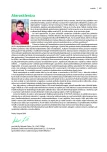Hyperlipoproteinemia and dyslipidemia as rare diseases. Diagnostics and treatment
Authors:
Richard Češka 1; Tomáš Štulc 1; Lucie Votavová 2; Lucie Schwarzová 1; Martina Vaclová 1; Tomáš Freiberger 3
Authors‘ workplace:
III. interní klinika 1. LF UK a VFN v Praze
1; ScreenPro FH, z. s., Praha
2; Centrum kardiovaskulární a transplantační chirurgie, Brno
3
Published in:
Vnitř Lék 2016; 62(11): 887-894
Category:
Reviews
Overview
Hyperlipoproteinemia (HLP) and dyslipidemia (DLP) are of course mainly perceived as diseases of common incidence and are typically seen as the greatest risk factors (RF) in the context of the pandemic of cardiovascular diseases. This is certainly true and HLP or DLP overall affect tens of percents of adults. However we cannot overlook the fact that disorders (mostly congenital) of lipid metabolism exist which, though not formally defined as such, amply satisfy the conditions for classification as rare diseases. Our account only includes a brief overview of the rare HLPs based on the dominant disorder of lipid metabolism, i.e. we shall mention the rare primary forms of hypercholesterolemia, primary forms of hypertriglyceridemia and the rare primary combined forms of HLP. In recent years an amazing progress has been reached relating to these diseases, in particular in the area of exact identification of the genetic defect and the mechanism of defect formation, however each of these diseases would require a separate article, though outside the field of clinical internal medicine. Therefore we shall discuss homozygous familial hypercholesterolemia (FH) in greater depth, partially also the “severe” form of heterozygous FH and in the following part the lipoprotein lipase deficiency; that means, diseases which present an extreme and even fatal risk for their carriers at a young age, but on the other hand, new therapeutic possibilities are offered within their treatment. An internist then should be alert to the suspicion that the described diseases may be involved, know about their main symptoms, where to refer the patient and how to treat them. Also dysbetalipoproteinemia (or type III HLP) will be briefly mentioned. Homozygous FH occurs with the frequency of 1 : 1 000 000 (maybe even more frequently, 1 : 160 000), it is characterized by severe isolated hypercholesterolemia (overall cholesterol typically equal to 15 mmol/l or more), xanthomatosis and first of all by a very early manifestation of a cardiovascular disease. Myocardial infarction is not an exception even in childhood. The therapy is based on high-dose statins, statins in combination with ezetimib and now also newly on PCSK9 inhibitors. Lomitapid and partly also mipomersen hold great promise for patients. LDL apheresis then represents an aggressive form of treatment. Lipoprotein lipase deficiency (type I HLP) is mainly characterized by severe hypertriglyceridemia, serum milky in colour, and xanthomatosis. A fatal complication is acute recurrent pancreatitis. A critical part of the treatment is diet, however it alone is not enough to control a genetic disorder. The only approved treatment is gene therapy. Experimentally, as an “off label” therapy, it is used in case studies with a lomitapid effect. We have our own experience with this experimental therapy. Dysbetalipoproteinemia is a congenital disorder of lipoprotein metabolism, characterized by high cholesterol (CH) and triglyceride (TG) levels. The underlying cause of this disease is the defect of the gene providing for apolipoprotein E. It is clinically manifested by xanthomatosis, however primarily by an early manifestation of atherosclerosis (rather peripheral than coronary).
Key words:
Lipoprotein lipase deficiency – dysbetalipoproteinemia – familial hypercholesterolemia – gene therapy – homozygous FH – LDL apheresis – lomitapid – mipomersen – PCSK9 inhibitors – rare diseases
Sources
1. Piepoli MF, Hoes AW, Agewall S et al. 2016 European Guidelines on cardiovascular disease prevention in clinical practice: The Sixth Joint Task Force of the European Society of Cardiology and Other Societies on Cardiovascular Disease Prevention in Clinical Practice (constituted by representatives of 10 societies and by invited experts)Developed with the special contribution of the European Association for Cardiovascular Prevention & Rehabilitation (EACPR). Eur Heart J 2016; 37(29): 2315–2381. Dostupné z DOI: <http://dx.doi.org/10.1093/eurheartj/ehw106>.
2. Catapano AL, Graham I, De Backer G et al. 2016 ESC/EAS Guidelines for the Management of Dyslipidaemias: The Task Force for the Management of Dyslipidaemias of the European Society of Cardiology (ESC) and European Atherosclerosis Society (EAS)Developed with the special contribution of the European Assocciation for Cardiovascular Prevention & Rehabilitation (EACPR). Eur Heart J 2016. pii: ehw272. Dostupné z DOI: <http://dx.doi.org/10.1093/eurheartj/ehw272>.
3. Santos RD, Gidding SS, Hegele RA et al. Defining severe familial hypercholesterolaemia and the implications for clinical management: a consensus statement from the International Atherosclerosis Society Severe Familial Hypercholesterolemia Panel. Lancet Diabetes-Endocrinol 2016; 4(10): 850–861. Dostupné z DOI: <http://dx.doi.org/10.1016/S2213–8587(16)30041–9>.
4. Goldstein JL, Hobbs HH, Brown MS. Familial hypercholesterolemia. In: Scriver CR, Beaudet AL(eds) et al. The metabolic and molecular bases of inherited disease. 8th ed. McGraw-Hill: New York 2001 : 2863–2914. ISBN 978–0071363198.
5. Hobbs HH, Brown MS, Goldstein JL. Molecular genetics of the LDL receptor gene in familial hypercholesterolemia. Hum Mutat 1992; 1(6): 445–466.
6. Innerarity TL, Weisgraber KH, Arnold KS et al. Familial defective apolipoprotein B-100: low density lipoproteins with abnormal receptor binding. Proc Natl Acad Sci USA 1987; 84(19): 6919–6923.
7. Fouchier SW, Dallinga-Thie GM, Meijers JC et al. Mutations in STAP1 are associated with autosomal dominant hypercholesterolemia. Circ Res 2014; 115(6): 552–555. Dostupné z DOI: <http://dx.doi.org/10.1161/CIRCRESAHA.115.304660>.
Labels
Diabetology Endocrinology Internal medicineArticle was published in
Internal Medicine

2016 Issue 11
Most read in this issue
- A diet suitable for patients with dyslipidemia and metabolic syndrome
- Hyperlipoproteinemia in children
- Hyperlipoproteinemia and dyslipidemia as rare diseases. Diagnostics and treatment
- Uric acid as a risk factor for cardiovascular diseases
